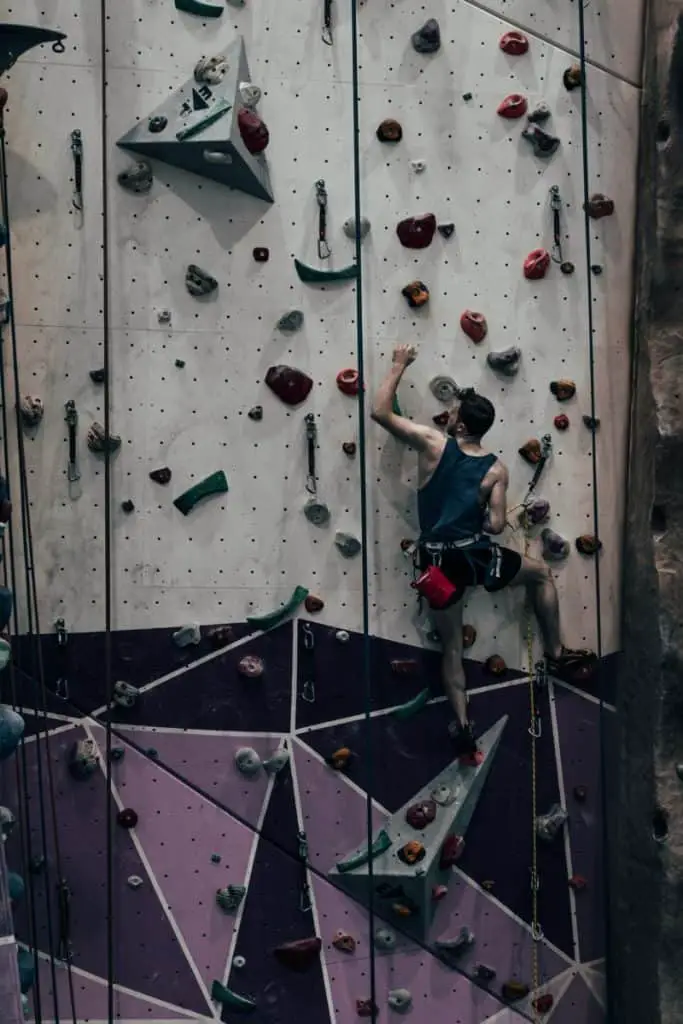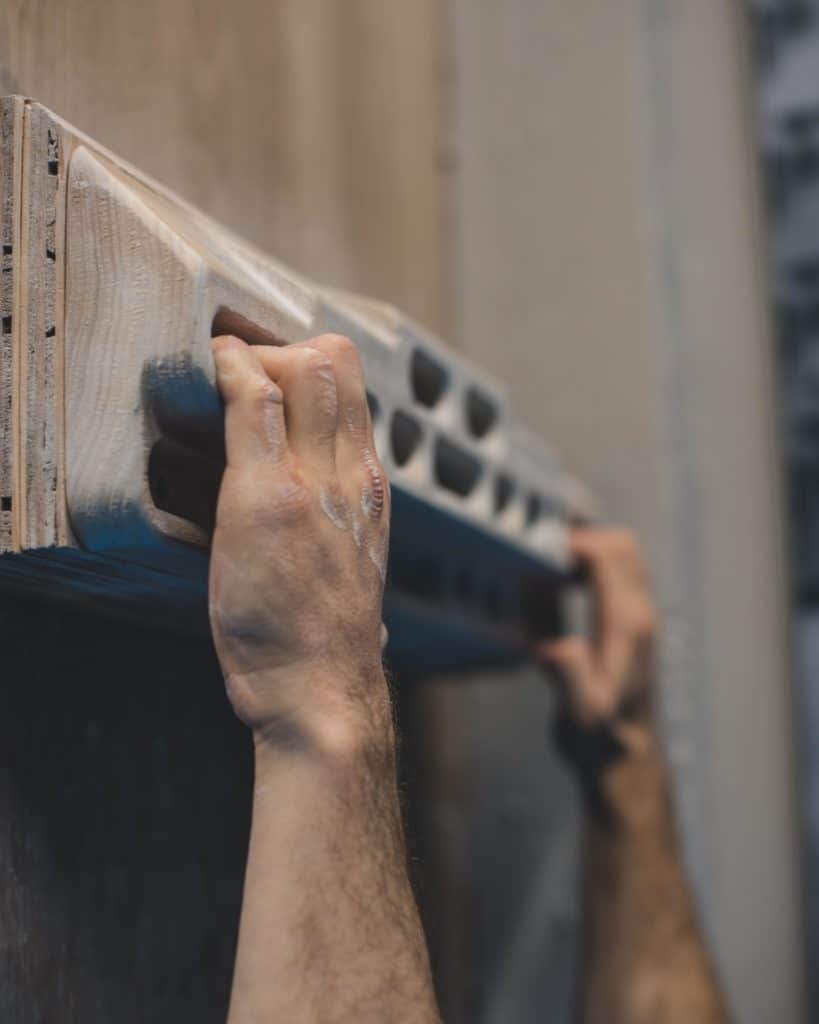
I’m sure you’ve watched lots of rock climbing videos, what have you noticed about the different climbers? Yes, they are healthy and skilled at what they do, but there’s something else – most of them are somewhat skinny! It’s rare to find a climber carrying excess weight. However, what you need to know is that their skinniness is for good reasons. In this article, we’re going to look at why most climbers are skinny and whether you can climb if you’re weighty.
So, why are rock climbers skinny? Rock climbing is one of the most strenuous sporting activities. It requires you to use your hands and legs to pull and push your body up as you scale the heights. Now imagine if you were excessively heavy, carrying that weight up can be challenging. The weight can take a massive toll on your arms and even hinder effective gripping. That’s why the weight of rock climbers is generally lower, and they look skinny. They can carry their lightweight body easily without exceedingly straining their arms. This means they can climb more comfortably and for longer.
Page Jumps
- The Importance of Strength to Weight Ratio of Rock Climbers
- Can Big Guys and Girls Climb?
- Best Ways to Lose Weight for Rock Climbing While Staying Strong
- How to Increase Climbing Strength
The Importance of Strength to Weight Ratio of Rock Climbers
What is the strength to weight ratio? In simple terms, it’s the number you get after dividing your strength by your weight. For instance, if your body weight is 70kgs and you can lift 100kgs, your strength to weight ratio (SWR) is around 1.4. Why should you care about SWR if you’re a rock climber? It determines how comfortably you can carry your body weight as you go up. A higher SWR indicates that while your body weight is low, you can carry a load with significant weight, and that means more power to help you climb easily.
Therefore, you should strive to improve your strength to weight ratio for better climbing efficiency. For people looking to improve their SWR, core work, and bodyweight exercises like pull-ups and pushups can help. Watching what and how you eat can also help.
Can Big Guys and Girls Climb?
As we mentioned earlier, excess weight can make the process of rock climbing very difficult. It’s a sport that requires you to carry your body to the top; therefore, the lighter your body, the easier you can carry it. But if you’re heavier, the more you’ll struggle while climbing.
Does that mean big guys and girls can’t climb? No, it doesn’t. Even if you weigh 100kgs, don’t let anyone discourage you from climbing. This activity isn’t all about competition, and you don’t have to push yourself to climb bigger heights. As long as you’re having fun and getting to grips with the wall (excuse the pun), that’s all that matters.
That being said, there are several things you can do to make climbing easy for you. One, let it be a gradual process. Choose places that aren’t steep at first to avoid straining your hands. You can go for harder climbing areas as your body gets used to the activity. Two, watch the technique you use to climb. Rather than relying on your hands to pull your body, use your legs to help push it up whenever possible.
Don’t use weight as an excuse to say you can’t climb, some professional climbers like John Dunne aren’t the skinny type, but they scale hard and steep places. Don Whillans was also a pretty heavy rock climber during his time, but he was excellent at what he did. Go out there, climb, enjoy yourself, but remember to stay safe.
Best Ways to Lose Weight for Rock Climbing While Staying Strong
Watch your diet

If you want to engage in competitive rock climbing and maybe bouldering, shedding those extra kilos is vital. One way you can lose weight while still staying strong is by watching how and what you eat – create a caloric deficit. One mistake people make is eating more calories than they need to maintain their body weight. However, you need to know that once your body has consumed the calories it requires, the others will be stored as fat. More fat storage means more weight, and that can be detrimental to rock climbing.
You can create a caloric deficit simply by reducing the amount of food you consume every day. When your body can’t get the calories it needs from food; it’ll burn the stored fat to produce energy. Burning more fat equals more weight loss. Other than creating a caloric deficit, watch what you eat as well. Reduce your carb consumption (especially refined carbs) and increase your protein, vegetable, fruit, and water intake.
I’ve created 6 different 7 day diet plans for people with all sorts of different types of diets including vegan, vegetarian, paleo, keto, pescatarian and “normal”. Hopefully these will help you.
Long-distance running
If you’re new to rock climbing, long-distance running is another excellent choice to get rid of excess fat and achieve ideal weight. It’s one of the best exercises that can help you burn calories without excessively stressing your joints and bones. And since you’re starting, you can do long-distance running/jogging at first and then alternate with shorter sprints later.
Please note that increasing the distance you run doesn’t necessarily mean you’ll lose more weight. For instance, it doesn’t mean you’ll shed five kilos by running eight kilometers instead of four. Know the distance to run and increase it as your body gets used to the runs. Most importantly, know when to take breaks to avoid injuries and allow your body to relax.
High-intensity interval training (HIIT)
If you’ve never heard of this training, it’s just like the name suggests – it involves shorter bursts of vigorous activity and alternating them with rests or low-intensity activity. The best thing about choosing HIIT workouts is that you don’t have to spend hours in the gym; you can complete the workout in as little as 15-30 minutes and gain its benefits.
As you engage in the high-intensity exercise, you’ll increase your metabolic rate, burn more calories, and shed weight. You can also build muscle and increase strength, a vital element in rock climbing.
Another great thing about HIIT is that you can even choose your favorite activity. For instance, if you’re a fan of cycling, cycle as fast as possible on a stationary bike for around 30 seconds and then rest or cycle slowly for 15 seconds. Repeat the process. If you love jumping rope, do it fast for 30 seconds and then do slow jumps for 15 seconds.
How often should you do HIIT in a week? Three or four times is okay, depending on how your body feels. Remember to increase your protein intake so that the body burns more calories, builds more muscle, and increases strength.
How to Increase Climbing Strength
Climb more often
Apart from losing weight and becoming lean, you may be looking for ways to build strength for efficient climbing. An excellent idea is to do the activity itself regularly. If you’re a beginner, you’re probably wondering the maximum amount you should climb per week to avoid injury. Check out an article I’ve covered on that topic here.
Rock climbing is a high-intensity sport that works out your whole and forces you to push your body to the limit. And as you push your body, you build strength. It improves the muscles in your core, arms, legs, and back. That’s why you’ll always climb better and more comfortably on your seventh time compared to your first time.
Hangboarding

Finger strength is one essential quality required for effective climbing. Skills are undeniably important, but for tough routes, finger strength is also crucial to pulling your body up. A great method to improve it is hangboarding. Get the right hangboard, mount it at the most suitable place, and hang from it using your fingers. That’s the fundamental explanation for this task.
A dead hang is the basic hangboarding exercise, but there are others you can try as you increase finger strength. You can even increase the intensity by adding some weight to your body. Remember to train several types of grips such as wide pinches, medium pinches, large edges, slopers, mono grips, etc. To hang-board effectively, position the board so that you can step on the ground after hanging for some time; dropping from a higher height may injure your fingers.
Remember also to bend your elbows a little bit while hanging, pull your shoulder blades up, tighten and activate your core, and position your head neutrally facing straight ahead. If you’ve been climbing for over 6 months, hangboarding two or three times a week is perfect.
Kettle Bells
Kettlebells are a fantastic way to increase strength and endurance for rock climbing. If you’ve ever been thinking about getting into kettlebells and you’re a climber, these two things go hand in hand.
Kettlebells improve the connective tissues and the hips when rock climbing. When it comes to connective tissues such as ligaments and tendons, kettlebell training strengthens them for more muscle power to use when climbing. And when these parts are stronger, it means they’re less prone to injuries.
For the hips, kettlebell training helps to improve an individual’s core and balance. A better core contributes a lot to having enough strength, better endurance, a stable body, and proper balance, qualities that make an excellent climber.
Check out an article I’ve written about how kettlebells can improve climbing here, including a kettle bell workout and how to use kettle bells safely.
Calisthenics
Calisthenics is a form of exercise that relies on your own body weight as the training equipment, and it’s another way to build strength. Examples of calisthenic exercises are pull-ups, pushups, sit-ups, chin-ups, lunges, trunk twists, planks, jumping jacks, and many others. To get maximum strength benefits, remember to target specific muscle groups such as your core. Apart from helping you build strength, calisthenics also improve endurance and flexibility, two other vital elements needed for effective rock climbing.
Working out
If there’s a gym in your area, then go there and work out. The best thing about choosing a gym is that you can find almost every strength training equipment: barbells, kettlebells, resistance bands, dumbbells, cable machines, and many others. The assistants at the gym can also guide you through the right ways to build strength for rock climbing. If there isn’t a gym near you, you can as well buy basic equipment to work out at home.
If you’ve ever been thinking about getting into kettlebells and you’re a climber, these two things go hand in hand. Check out an article I’ve written about that here.
There are lots of work-out exercises for strength training using various equipment: bench presses, overhead presses, incline bench presses, bent-over rows, deadlifts, dumbbell curls, and many others. Choose the ones you feel are more suitable for you.
Hopefully, this article answers your question on why are rock climbers skinny. The lighter you are, the better you can carry your body as you go up. However, this should not serve as a discouragement to weighty individuals. As long as you’re having fun, enjoying yourself, and staying safe, sometimes that’s all that matters. Rock climbing can even work to your advantage and help you shed some kilos. If you don’t know where to start, you can always get some training and tips at a rock climbing gym.
